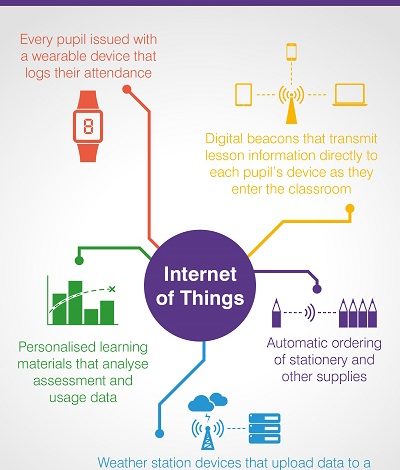
The “Internet of Things” (also called The Internet of Objects), a concept coined by Peter Lewis in 1985 refers to a network of physical devices, vehicles, buildings and other items—embedded with electronics, software, sensors, and network connectivity that enable these objects to collect and exchange data.
The Global Standards Initiative on Internet of Things (IoT-GSI) defines it as “the infrastructure of the information society that allows objects to be sensed or controlled remotely across existing network infrastructure, creating opportunities for more direct integration of the physical world into computer-based systems, and resulting in improved efficiency, accuracy and economic benefit in addition to reduced human intervention.
The IOTs is a Network of Networks connected with added security, analytics, and management capabilities. It is the connection of everything that can be connected and viewed as the next stage of the information revolution.Thanks to cheap processors and wireless networks, anything with a sensor can become part of the IoT.
“Things,” in the IoT refers to a wide variety of devices with built-in sensors. These are “things having identities and virtual personalities operating in smart spaces using intelligent interfaces to connect and communicate within social, environmental, and user contexts”.
The interconnection of these embedded devices is expected to usher in automation in nearly all fields, allowing for virtually endless opportunities and connections to take place.
Even though The Internet of Things is in its early stages, experts view it as a game changer.In 2015,for example, the world population was estimated to be 7.3 billion. At that time, the number of connected devices was 25 billion, making the connected device per person to be 3.47. The projected world population in 2020 is 7.6 billion and the projected connected devices is estimated to be 50 billion, accordog to theGarnet Inc., a technology research and advisory corporatin. This puts the connected device per person at 6.58.
According to the US National Intelligence Council (2008), by 2025 Internet nodes may reside in everyday things—food packages, furniture, coffer makers, vehicles, paper documents, and more will be talking to us and to each other. Experts predict that nearly everything we own will be equipped with a sensor, and that the number of wearable data devices will increase significantly. The question is, what happens if 50 billion things become connected. No wonder, some have used the term “the Internet of Everything (IoE)” to refer to the convergence of people, process, data and things, bringing about unprecedented disruption.
A number of factors such as the availability of broadband Internet, decreasing cost of connectivity, emergence of Wi-Fi capability devices with built in sensors, the convergence of multiple technologies such as wireless communication, real-time analytics, embedded systems, an increased penetration of smartphones, and others are facilitating the development of the IOT.
In addition, a series of intermediate technologies such asRadio-Frequency Identification (RFID), wearable technologies, miniature computers, wireless connections and others are acting as enablers of this gigantic network.
Practical applications of IoT technology can be found in many areas today, in agriculture, in healthcare, in management, in transportation, in home automation (also known as domotics), and others.
Practical applications of IoT technology can be found in many areas today, in agriculture, in healthcare, in management, in transportation, in home automation (also known as domotics), and others. Today, we talk about “smart cities” where we have intelligent traffic and parking management, and automated building resource management. We refer to smart traffic control and remote vehicle control systems where we see self-driving vehicles that communicate with each other, the road, pedestrians, and street lights. We refer to smart environment where programmes like solid waste management using sensor intelligence and location tracking are helping to create a cleaner, greener environment. We talk about smart health where medical personnel and health care providers deliver health services to remote populations via a network that supports voice, video and intelligent medical devices. And there is talk about smart agriculture where precision farming based on data from field sensors can be used to maximize crop production. Storage facilities can also be controlled for these parameters to minimize spoilage. Real time agricultural and weather updates to mobile devices is expected to keep farmers informed of critical and actionable information.
The education sector is one area where the IoT has been applied widely, to enhance the quality of teaching and learning. IoT technology has led to the creation of smart classrooms through connected classroom devices such as smartboards, scanmarker, and sweetrush. Also, technologies such as augmented and virtual reality (AR/VR) have the tendency to immerse students in a new learning environment by providing them with detailed information on objects studied in class. Seamless integration of these IoT gadgets will provide several competitive advantage to the institution.
Anytime, anywhere learning has now become the norm with some academic institutions. And, it is IoT technology through the Internet that has made it possible to link students in physically unconnected places to global educational resources. This is made possible through the use of learning management systems which allows instructors to organize all the resources needed by students under a single platform.
IOT technology has been deployed in the classroom to track student attendance and to personalize the learning process. The incorporation of such learning analytics into teaching and learning through the deployment of IoT devices has helped identify at-risk students, and their engagement level.
IoT technology has made it possible for new pedagogical methods to emerge. Educational institutions are gradually moving away from traditional face-to-face teaching to innovative course delivery methods such as open and distance learning, flipped classroom, blended learning, and others.
Such technologies are compelling because they make the things around us smarter and more interactive.
Nana Prof. OseiDarkwa, President
African Virtual Campus



